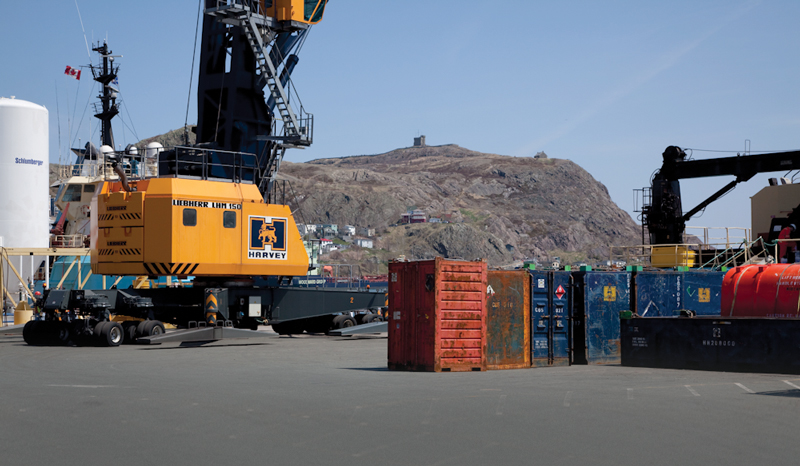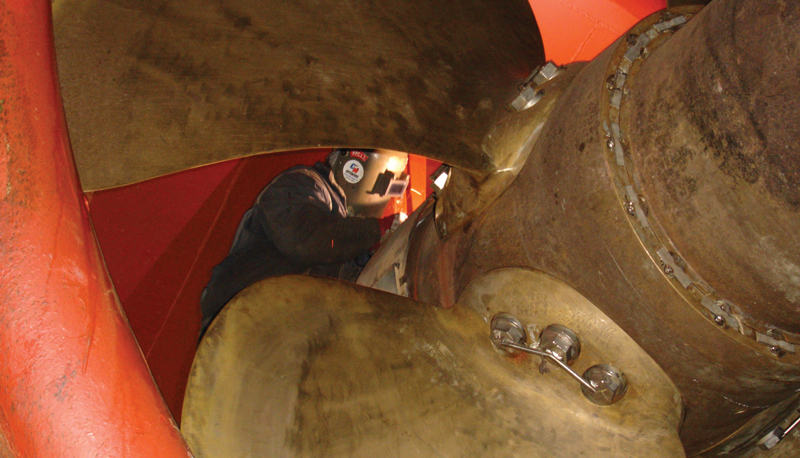Account Login
Don't have an account? Create One

It’s hard to underestimate the importance of seaports to the Canadian economy. In Atlantic Canada, it’s impossible. This region is to the sea what the prairies are to the land—deeply integrated by history, commerce and lore.
From food security and cruise traffic, to manufactured goods and resource shipments, port trade plays a crucial role in the health and wealth of towns and cities—providing access to international markets and incoming goods and services, employing thousands of people and generating millions of dollars a year in GDP.
That may be increasingly evident as the value of ports and port-related businesses becomes even more significant with the rise of new, emerging—and re-emerging—offshore energy opportunities, including green hydrogen and wind turbine development.

Speaking to Sean Hanrahan, president and CEO of the St. John’s Port Authority, it’s hard to escape the conclusion that when he describes the role the multifaceted Port of St. John’s plays in the city, the province, the nation and, indeed, the world, he’s not just talking about moving goods and people around like so many pieces on a playing board.
“We are a strategic hub, a diverse service centre that generates thousands of jobs and welcomes visitors from around the world,” he says, adding: “For that reason, alone, we need to be thinking about tomorrow, today. We need to be engaging all the time; working with our industry partners to grow our Port together.”
In fact, that doesn’t appear to be problematic for the Port, which points its daily management compass at safety and security, sustainability and collaboration, and giving back to the community. As for the bottom line, it sets cargo shipping, offshore energy supply and service, marine maintenance and repair, the fishing industry, and the cruise business as cornerstones of its business model. And business is good.
In 2022, Dry Bulk (104,912), Liquid Bulk (515,737), and General Cargo (787,794) together amounted to more than 1.4 million total tonnes. Meanwhile, that year, more than 1,100 offshore (552) and other (554) vessels arrived.
Amidst this thrumming activity, substantial upgrades to both Piers 20 West and 21 are underway to further enhance the fishing industry with increased capabilities to move fresh product to market. Technological advancements are also being implemented to move cargo more efficiently, which will improve land-side and vessel-side operations by increasing gate throughout, data visibility, and by making better use of the available land at the main terminal.
Says vice-president of development, Bob McCarthy: “Overall, this will streamline operations to meet increasing demand, as well as reduce supply-chain congestion, greenhouse gas emissions, and the port’s overall carbon footprint… One thing we have to be here in St. John’s is creative with the space that we have avail-able to us. That means becoming more efficient with the implementation of technology. From a supply chain perspective, St. John’s has a very key role to play. Half of all the general cargo in Newfoundland and Labrador comes through here.”
That fact is certainly not lost on Hanrahan who sees the Port’s progress now and in the coming years—when new and burgeoning offshore, renewable energy, resource, and tourism industries are poised to grow—as a virtuous game of dominoes.
“Lookit,” he says, “With a combination of good luck and sound management, the Port has managed to survive the COVID threat. And that was really because we have such a diversity of services and partners. When you’re doing a lot of things with a lot of people, you can weather the storms. It’s simple: Diversification has its rewards.”
It also has a terrific knock-on effect. “Post-COVID, the positivity didn’t end; it was kind of bolstered. For example, cruise operations returned stronger than ever. Also, there’s new supply chain opportunities in the hydrogen and wind energy sector. We are on the periphery of that now, but we are looking and positioning to dive deeper… Positivity is on the way up here.”
It shows, and not just in the numbers.
“Because of what we do and how we operate, the Port really plays a big part in the life of the broader community. Beyond the cold calculus of balance sheets, our Community Investment Initiative, in which we annually give 0.5% of our operating revenue to charity, has been doing some great things. It’s approximately $40,000 a year distributed, through the United Way, to various deserving community causes.”
As he says, the collaboration and planning between the people and partners that make up the port have been key ingredients to their success, and they are the guiding light toward a bright future for the port.

It’s not enough for QSL just to talk about the opportunities in store for the Atlantic region’s seaports. This leading Canadian marine services company—with 64 terminals across North America—is determined to play a key role bringing these new investments to life for the people it employs and the communities in which it operates on the East Coast.
Or, as QSL’s vice president, Atlantic, Bruce Graham puts it: “We are putting our money where our mouth is when it comes to investing in the local industry and marketplace. We’re strong because we’re helping our clients and our ports be strong.”
A case in point is the Port of Sheet Harbour, N.S., where QSL became the port operator in 2022. Since then, the company has captured enough new business to help push the port’s annual through-put from 150,000 tonnes to an estimated one million, or more, in 2024-25. “There, we’ve been investing in new equipment, which essentially lets us both tap into new, offshore markets and support local industry,” Graham says. “For example, we’re bringing in two, brand new 170-foot, 54-inch stackers so that we can support quarry operations, where aggregate is produced for domestic use and export.”
At the Port of Argentia, N.L.—where QSL handles everything from steel products to project cargo through its Integrated Logistics subsidiary—the company recently spent $5 million updating its warehousing capabilities to better serve its clients who are preparing to jump on new opportunities in wind and other renewables.

“At QSL, we work tirelessly to be a North American industry leader by partnering with our clients to help them thrive, by actively participating in the growth of the Canadian and U.S. import and export markets and by making a difference in our communities.”
—Bruce Graham
At Port of Belledune, N.B., QSL is working hand-in-glove with authorities and stakeholders to develop the green-energy hub—a specialized district on port lands welcoming low-carbon projects and industries. New and exciting, the initiative is also rooted in a productive partnership that stretches back a generation or more. Says Graham: “QSL and the Port of Belledune have been working together for more than 25 years. The opportunities in front of us there actually reflect our commitment to the sustainability of our long-term relationship.”
In fact, a clear vision of the future, and no small degree of grit and determination, have played a leading role in transforming what was a modest stevedoring company in 1978 into a key logistics chain player in North America. Now a business of 2,000 employees in Canada and the USA, QSL handles over 26 million tonnes of cargo annually.
Its investments and capabilities are evident each and every day at the operations of the Port of Halifax (Ocean and Richmond Terminals); in Saint John, N.B., and Summerside and Charlottetown, P.E.I. (where QSL works alongside Coastal Stevedoring); at the Ports of Goose Bay and Long Pond as well as Argentia in Newfoundland. Here—with our JV integrated logistics and its unparalleled handling capabilities and expertise—it moves cargo seamlessly and intermodally all over the world.
The opportunities in store for Atlantic Canada’s seaports—particularly renewable energy projects and sustainable development initiatives for domestic and international markets—are framing the next chapter in QSL’s investment in the region’s businesses, workforce, and communities.
“Atlantic Canada’s ports are strategically positioned—in terms of their geographic position, technical prowess and occupational know-how—to succeed now and in the future,” says Graham. “We are playing a direct role in the green energy transition because it’s good for business, good for us, and good for the people and communities we continue to serve.”

Describe the Port of Argentia and the word “busy” does, indeed, spring to mind. But for its effusive CEO Scott Penney, industrious is good.
“We’re diversifying and directing our focus in five key sectors—renewable energy, critical minerals, marine transportation, aquaculture, and oil and gas,” he says. “Additionally, we’re in the infrastructure investment business, with a new $100-million dock extension project to support all of these different sectors. Frankly,we’re pretty jazzed about all of it.”
Over the past couple of years, the Port’s marine terminal—featuring a 40-hectare secure compound adjacent to 430 metres of docking facilities—has positioned itself to play a direct role in promising industrial and economic opportunities for both the Placentia region and the province.
Utilizing its tremendous land assets, Argentia has established North America’s first monopile marshalling port supporting the U.S. offshore wind industry.
Further diversifying, the Port is expanding its support to the aquaculture industry with a new, dedi-cated wharf development. It’s the host site of Cenovus Energy’s concrete gravity structure build for the West White Rose oil project, scheduled for tow-out in 2025. Meanwhile, Bay du Nord oil and gas project lead Equinor has identified Argentia as a suitable location for a pipe spool base facility for subsea developments.
Most recently, a 50:50 joint venture between the Port and investment firm Torrent Capital Inc., and, Pattern Holdings Canada 2 ULC (announced June 5) will create Argentia Renewables, a planned renewable wind energy to green fuels project at Argentia. Says Penney: “This exemplifies how we’re moving towards the future. We want to be the powerhouse for the energy transition that’s coming. That means seeking equity stakes in projects and keeping as much revenue here as possible.”
Argentia is busy, but as long as the projects keep coming, Penney’s not complaining.
“It really is like we’re drinking out of the firehose.”

Covering their bases in the complex and competitive world of marine logistics, supply and service is certainly St. John’s-based A. Harvey & Company’s top priority. The firm has been serving Newfoundland and Labrador for over 150 years with its focus trained on its offshore marine base at the Port of St. John’s and, increasingly, its freezer and terminals operation at the Port of Argentia.
Says vice-president of Operations, Geoff Cunningham: “From our St. John’s marine base, we’ve been regularly resupplying every offshore installation since the late 1960s. As well, since the 1980s, we’ve become an active player at Argentia.”
Indeed, the operations at both locations are comprehensive.
The St. John’s marine base provides seven vessel berths; 12 acres of laydown area quayside; and a container storage and repair depot. It offers logistics planning, stevedoring, container rentals management, material handling, trucking, water and 24/7 security.
Meanwhile the Argentia freezers and terminals division—which is government-licensed for inspection and repackaging—is the largest Port employer providing stevedoring, a marshalling yard, computerized warehousing and handling, freezer storage, and cargo transfer operations. It can handle cargoes of fish products, containers, structural steel, pipes and casings, modular buildings and autos. “We also have 28,000 square-feet of freezer storage,” Cunningham says. “And, we are an alternative port for our St. John’s operation should the need arise.”
These multifaceted capabilities at two major ports position A. Harvey for future growth and diversification. Says Cunningham: “We’re certainly not at capacity at St. John’s at this point. But should we ever get there, then we’re certainly well-equipped to increase our footprint at Argentia, which is likely to be a busy player in the subsea construction phase of Bay du Nord [oil and gas] project.”

For Wayne Ash, general manager of Newdock—one of the oldest shipyards in Canada, located in the Port of St. John’s—decades of hard work is a pay-it-forward proposition.
“We’ve been around since 1884, and I think the secret has always been to provide dedicated and high-quality service,” he says. “Our customers know us and trust us to get the job done well, on time and according to budget.”
In fact, Newdock’s specialized workforce includes more than 300 certified professionals, many of whom can trace the family roots of their marine craftmanship back several generations. Over the past decade, they’ve plied their various trades to refurbish and maintain propulsion systems, steering systems, hulls, decks, bulkheads, piping systems, electrical systems, and more. The over 600 vessels they have repaired and upgraded over that span have run the gamut, including: Canadian Coast Guard, navy, offshore supply and seismic vessels; as well as commercial tugs, barges, and traditional and aquaculture fishing vessels.
The shipyard’s technical capabilities are, indeed, impressive: An 18-acre waterfront worksite in ice-free, sheltered conditions; a 4,000-tonne marine elevator; three 100-metre docking berths; a 174-metre drydock; two fully serviced piers; 6,500 square metres of manufacturing space, including steel machining and fabricating capabilities; shore power; plentiful fresh water; and the ability to service many vessels at one time.
This unbeatable combination of human and technical resources is positioning Newdock to make the most of new and emerging marine and offshore opportunities. Says Ash: “I just received an expression of interest request from Canadian government representatives regarding the new Arctic patrol ships in service. Would we be interested in servicing those vessels going forward?” These are the sort of opportunities that occur “when you have the track record and the demonstrated ability” to deliver.
“In the end,” he says, “it’s our determination to exceed, not just meet, customer requirements that counts.”

Since coming out of retirement to take over as CEO of the Port of Long Pond in Conception Bay South, N.L., Captain Mark Turner has announced plans to improve its safety and longevity, extend its existing pier, build a new jetty for domestic and international trade, and establish infrastructure that supports green energy development. And that’s only since February.
To say that Turner—a Transport Canada-certified maritime master with 38 years’ work experience encompassing marine, oil and gas, project, regulatory, legal, educational and corporate management—is ambitious about the port’s future is an understatement. As Turner says, “The time is right, the opportunity is real.”

“We’re going to go after new business as we reduce carbon emissions, maintain a strong safety record and a safe environment for recreational users. The objective is to ensure our long-term sustainability and functionality for diverse users.”
—Captain Mark Turner
Specifically, for Long Pond, these opportunities include: Recent developments in offshore oil and gas; new renewable energy initiatives; growing international import/export business; expanding projects in the mining industry; and increasing interest from cruise lines.
Currently, Long Pond—which offers, among other things, berthing for two, 245-metre vessels; offshore cargo-carrying containers and modular workspaces; and a complete suite of port services and supply chain logistics—is well-positioned. Still, Turner says, “We’re going to go after new business as we reduce carbon emissions, maintain a strong safety record and a safe environment for recreational users. The objective is to ensure our long-term sustainability and functionality for diverse users.”
In fact, it’s all in the Port’s new brand, which Turner also approved recently. “The Steadfast Connections tagline is reflective of the port’s long history of establishing meaningful business connections and providing support to many industries since its inception nearly 100 years ago. The new look is forward-thinking and representative of the Port’s commitment to marine operations, the environment and safety, while representing an established operation with openness and accessibility… It’s all about enhanced economic development for the Port, the town, and the region now and in the years ahead.”
Comment policy
Comments are moderated to ensure thoughtful and respectful conversations. First and last names will appear with each submission; anonymous comments and pseudonyms will not be permitted.
By submitting a comment, you accept that Atlantic Business Magazine has the right to reproduce and publish that comment in whole or in part, in any manner it chooses. Publication of a comment does not constitute endorsement of that comment. We reserve the right to close comments at any time.
Cancel